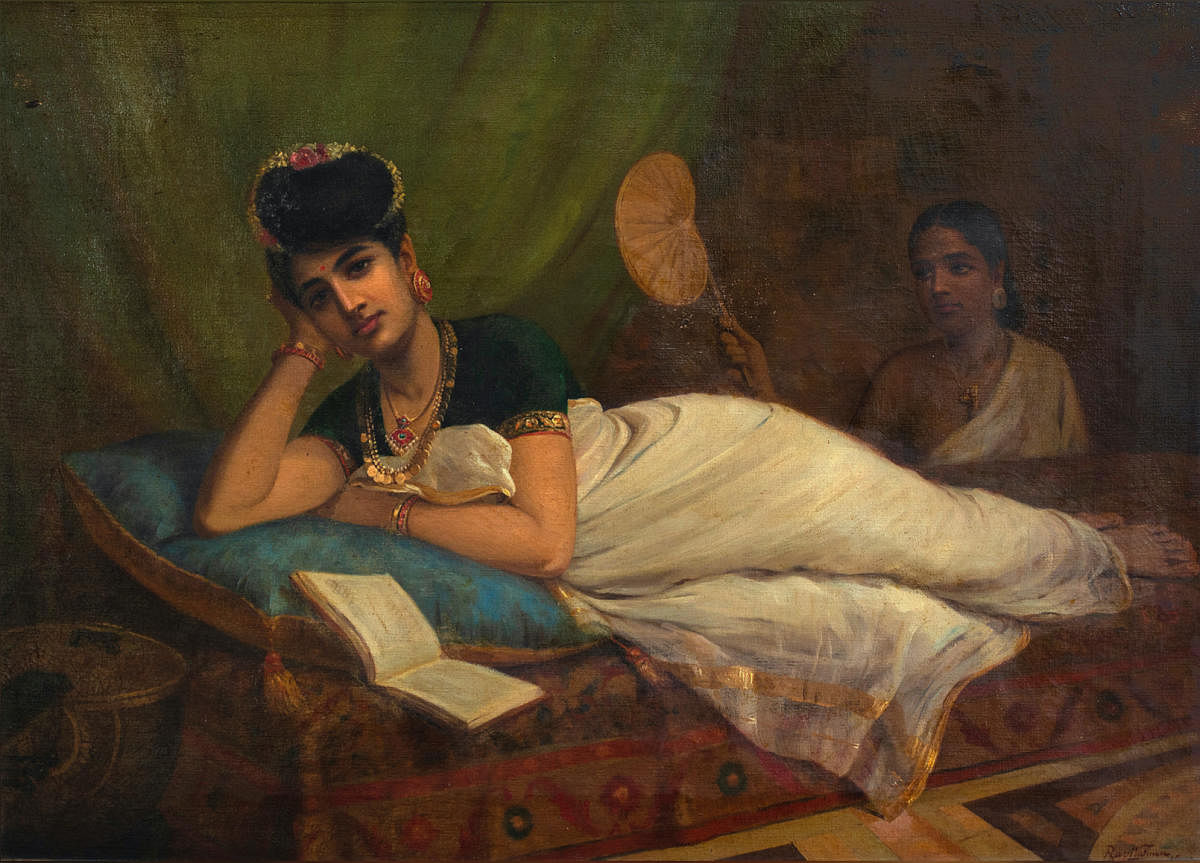
Raja Ravi Varma. The very name conjures up an imaginary world of beautiful well- proportioned women with translucent fair skin, large khol eyes, long hair curved around white mogra flowers, draped in gorgeous rich textured silk saris and adorned with large precious stone-studded gold jewellery. These images are so deeply ingrained in the minds of every Indian that whenever we think of any nobility from the pre-photography days, we automatically imagine them to be in this mould.
This is the kind of influence the works of the great 19th century artist Raja Ravi Varma has had for generations on all Indians. So much so that even our film and TV industry adopts this image to dress up their actors, whenever they make a film or a serial based on stories from mythology or history.
Born in Travancore on 29th April 1848, Ravi Varma’s paintings are considered to be the best examples of the fusion of European techniques and Indian sensibilities. He was also the first Indian artist to make affordable lithographs of his paintings with the result his art didn’t remain only on palace walls, but also reached the public. He was closely associated with the royal family of Travancore. Two of his granddaughters were adopted by the family and the present-day members of the royal family are from this lineage. But the ‘Raja’ is a title added after 1904 when Viceroy Lord Curzon awarded the Kaisar-I-Hind gold medal to him.
He is also famous for depictions of Hindu deities and episodes from mythology. Especially well-known are his paintings of Goddess Lakshmi draped in a red sari standing on a red lotus in a lake with swans and that of the veena-playing Goddess Saraswati wearing a pristine white sari with a golden border, sitting on a rock on the banks of a river with a peacock at her feet. Another painting of Damayanti (of the Nal-Damayanti story fame), draped in a red silk sari talking to a swan perched on a short stone pillar is so famous that in 1971, the Government of India released a stamp to honour the artist with this painting in the background.
The ‘dark’ mother-in-law
Most of his images are of pristine beauty. “Except for one!” says young historian Manu S Pillai who was approached by The Raja Ravi Varma Heritage Foundation (TRRVHF) to research and bring out a pictorial book on the artist to commemorate his 172nd birthday. Continuing, the historian who has authored three books, says, “For a man famous for helping popularise a new ideal of Indian beauty, with fair skin, gentle demeanours and certain types of features, in one of his paintings of a woman, titled mother-in-law, he defies all such expectations. The woman in the canvass is dark, glares out of the painting and is unapologetic in her posture and attitude. There is something very striking about that. Here, he didn’t tamper with her face, skin colour or even her aggressive eyes. And if ever possible, I would love to own that painting!”.
The TRRVHF was started in 2015 by well-known painter and writer Rukmini Varma, the fourth generation of Ravi Varma’s family and her son Jay Varma, also a painter known for his work of graphite on paper and charcoal on canvas.
Gitanjali Maini, the managing trustee and CEO of the Foundation, explains: “This foundation was started with the intention to preserve and promote his artistic legacy. His versatility wasn’t recognised. In many ways, Ravi Varma was a visionary. We wanted to bring out these hidden aspects.”
Online collection
For the past five years, the Foundation has been organising lavish events on his birth anniversary, including seminars and discussions with international and Indian scholars and writers by focusing on certain aspects of his paintings. Like last year, the botanical elements in his works was the subject; previously, the princes and patrons whom he painted, were discussed. This year, due to the Covid-19 situation, the discussion was conducted on a webinar by collaborating with Google Arts and Culture and the topic was ‘impact of the printing press in Ravi Varma’s life and art’.Cinematographer Vikas Urs was roped in to make a short film titled ‘Wanderers between worlds’.
Talking about the title of the film, Vikas, in the memorial webinar, said, “Ravi Varma, along with his artist brother Raja Varma, travelled the entire length and breadth of India and incorporated elements he observed in his paintings. Hence the title ‘Wanderers.’” Pillai observed that Ravi Varma was an extremely hardworking, ambitious professional. “Despite all the fame, wealth and prestige he had earned, he was deeply vulnerable at the time he died. His last letter gives us a glimpse into the man behind the glamourous artist, rather than the mythologised painter-prince figure we usually encounter,” he signs off.
Still a lot to learn about the artist who has almost become a family member of every Indian.